
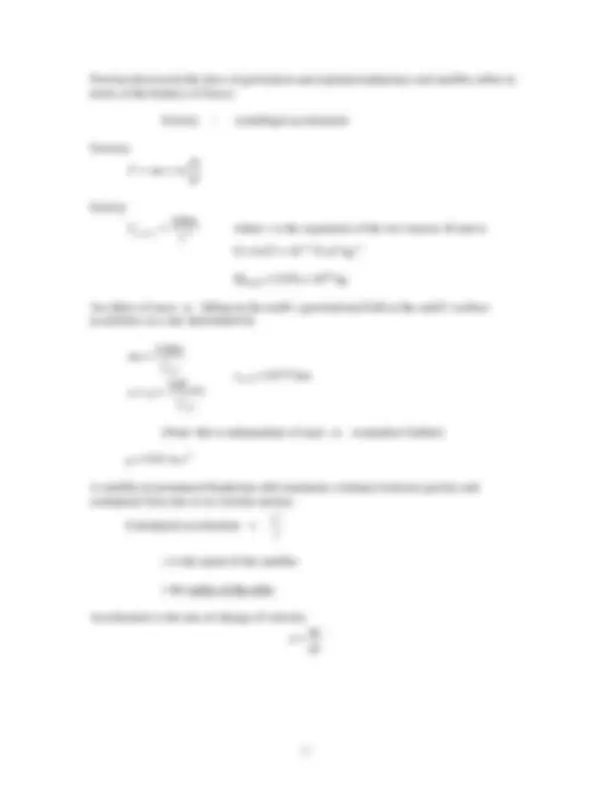
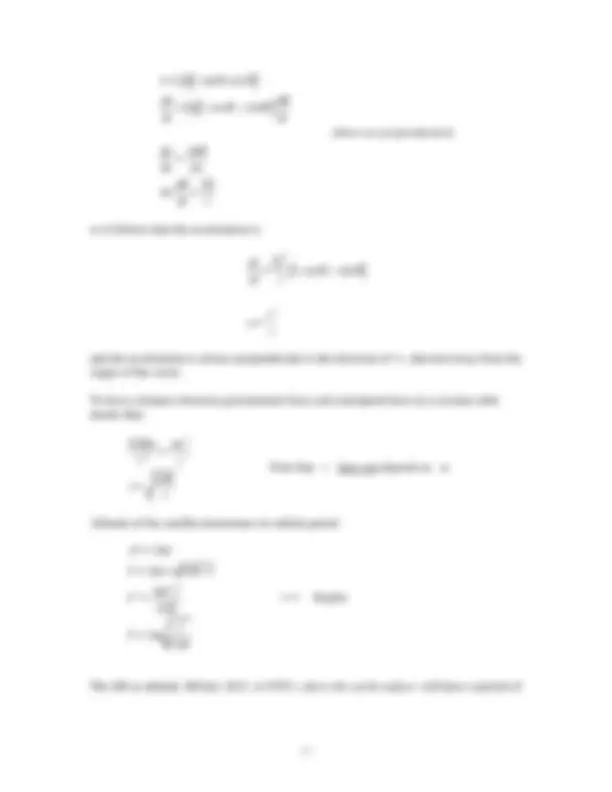
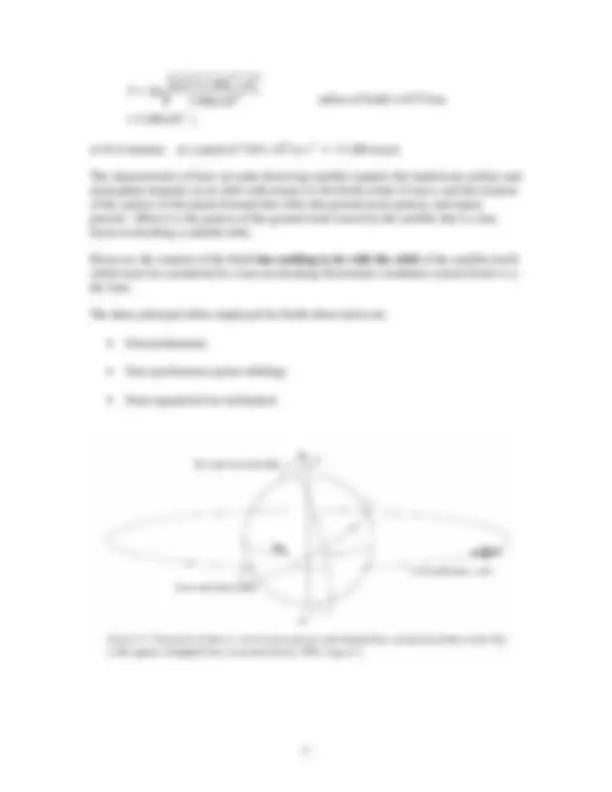
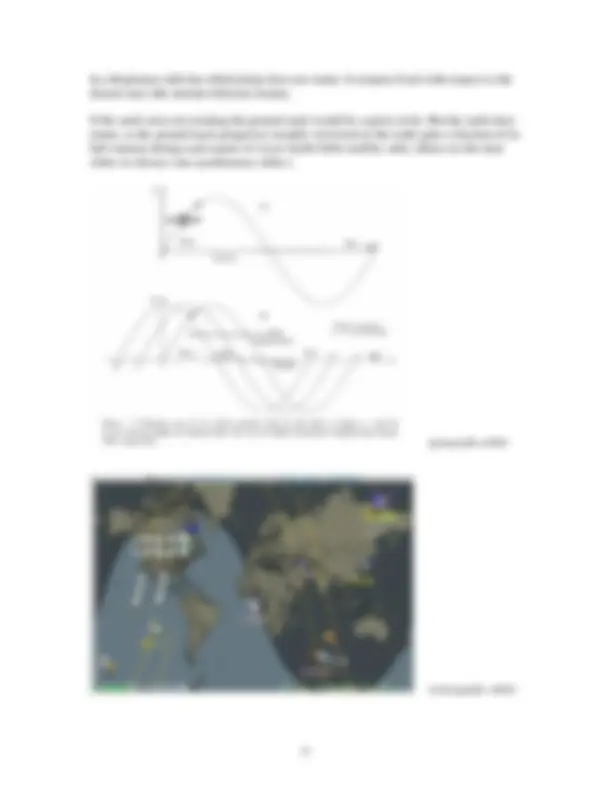
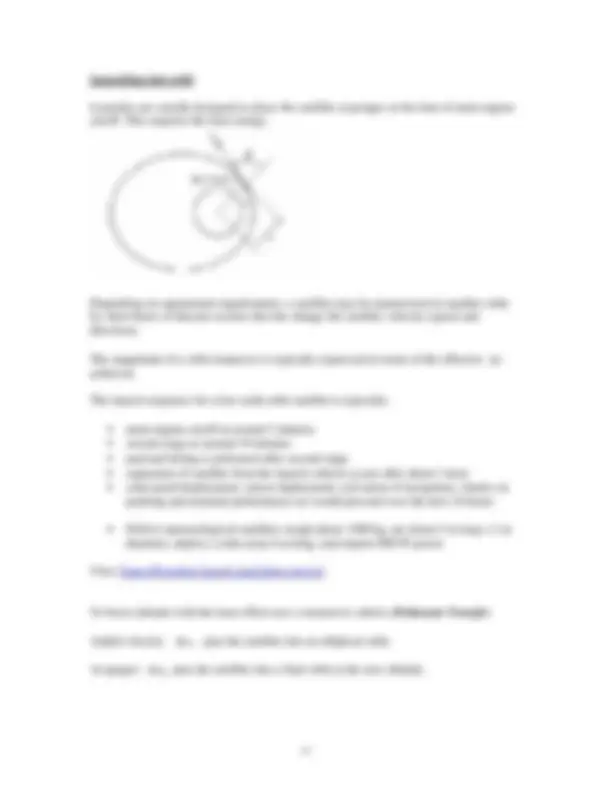
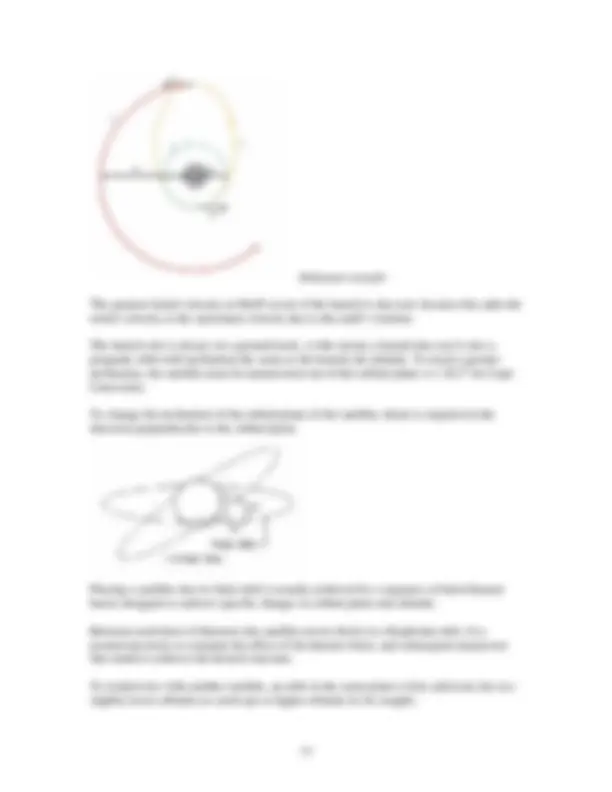
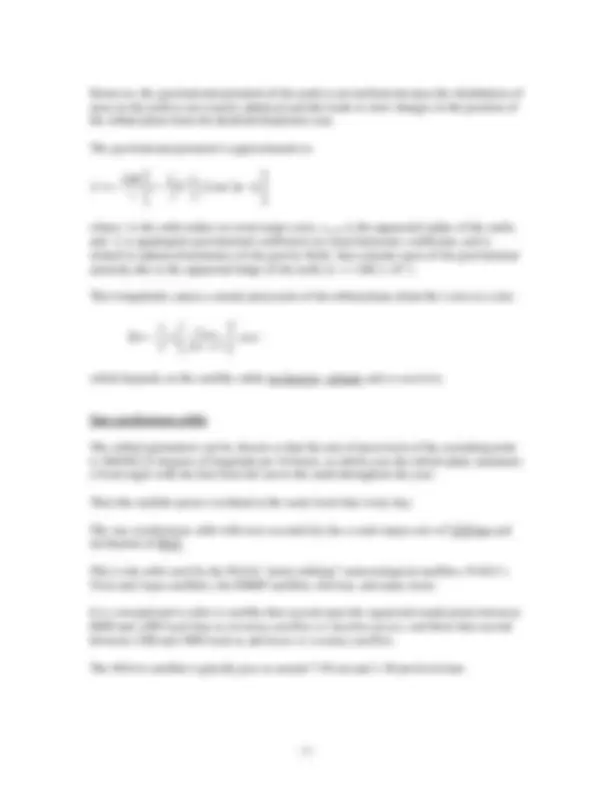
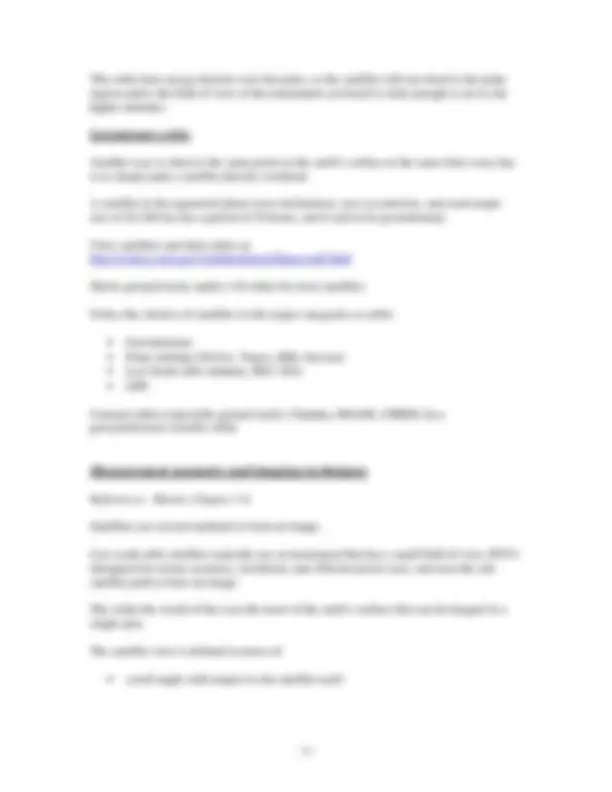
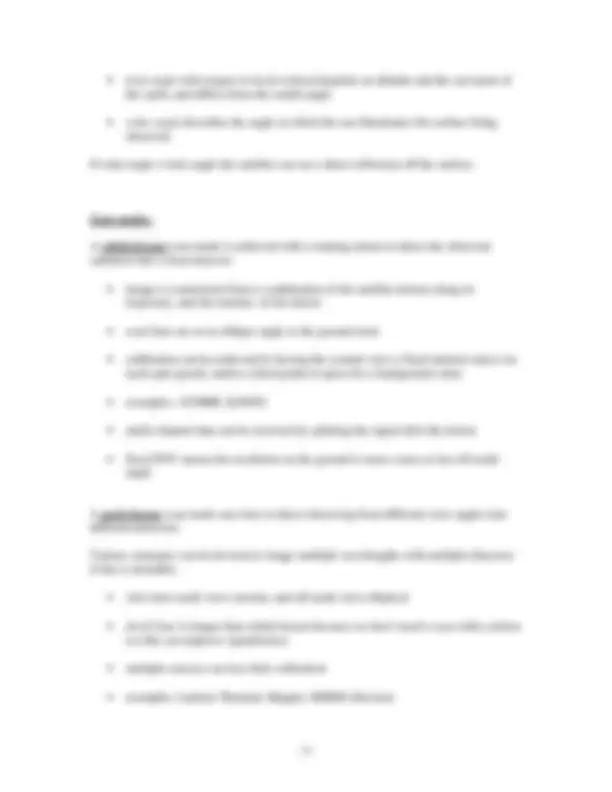


Study with the several resources on Docsity

Earn points by helping other students or get them with a premium plan


Prepare for your exams
Study with the several resources on Docsity

Earn points to download
Earn points by helping other students or get them with a premium plan
Community
Ask the community for help and clear up your study doubts
Discover the best universities in your country according to Docsity users
Free resources
Download our free guides on studying techniques, anxiety management strategies, and thesis advice from Docsity tutors
The principles of satellite remote sensing for ocean and atmospheric applications, focusing on satellite orbits, measurement geometry, and the impact of water phenomena on satellite signals. Topics include satellite sensor systems, field of view and ground-track sampling, orbit determination, and operational issues. The document also discusses the historical background of satellite orbits and kepler's laws.
Typology: Study notes
1 / 16

This page cannot be seen from the preview
Don't miss anything!










John Wilkin 732-932-6555 x 251 / 609-933-7753 jwilkin@rutgers.edu IMCS Room 214C
Remote Sensing of the Ocean and Atmosphere: 11:670:451 / 16:712:
Lectures 2 and 3: Satellite orbits and Measurement Geometry
Satellite Remote Sensing Systems
The flow of information from land, ice and ocean surface to satellite to user depends on features of the earth surface phenomena, the atmosphere, and the satellite observing system.
Satellite position
Critical to several aspects of the data set acquired by the sensor:
Operational issues
Higher altitude – more energy required from launch vehicle, less drag, more stable orbit
On orbit, and getting to orbit – don’t smack into anything else
Sun-satellite angle affects thermal state, available power, solar wind perturbations to orbit stability and electronics, ground communication
Satellite position ( ephemeris ) is determined principally by orbital physics, with influence from satellite dynamics (drag, roll, pitch, moment of inertia)
Physics of satellite orbits
50 years before Isaac Newton, Johannes Kepler analyzed data on planetary movements and deduced that:
Substitute satellite for planet and earth for sun in the above rules and they apply for artificial earth satellites.
For planets, a convenient unit of time is Earth Years, and for distance the Astronomical Unit (A.U.) being the distance from the Sun to Earth.
Then, trivially, R^3 = T^2 (because both units = 1)
For Mars, the orbital period is 1.88 Earth years, so
R = T2/3^ = (1.88) 2/3^ = 1.52 A.U.
which is indeed the average radius of the Martian orbit. (see e.g. http://www.windows.ucar.edu/tour/link=/our_solar_system/planets_table.html)
sin , cos
cos , sin d d dt dt
s r t t d dt r
θ θ θ θ θ
θ
θ
v v v v
v
(these are perpendicular)
so it follows that the acceleration is
2
2
cos , sin
dv^ v dt r
v a r
and the acceleration is always perpendicular to the direction of v , directed away from the origin of the circle.
To have a balance between gravitational force and centripetal force in a circular orbit means that:
r
v
r
mv r
GMm
2 2 Note that v does not depend on m
Altitude of the satellite determines its orbital period
2 3 2
3
vT r T r GM r r T GM r T GM
<<< Kepler
The ISS at altitude 360 km (D.C. to NYC) above the earth surface will have a period of
x s
x
x T
3
14
3 9
radius of Earth is 6373 km
or 91.6 minutes at a speed of 7.69 x 10^3 m s -1^ = 17,200 m.p.h.
The characteristics of how an earth observing satellite samples the land/ocean surface and atmosphere depends on its orbit with respect to the Earth center of mass, and the rotation of the surface of the planet beneath this orbit (the ground track pattern, and repeat period). Often it is the pattern of the ground-track traced by the satellite that is a key factor in deciding a suitable orbit.
However, the rotation of the Earth has nothing to do with the orbit of the satellite itself, which must be considered in a non-accelerating Newtonian coordinate system fixed w.r.t. the stars.
The three principal orbits employed for Earth observation are:
Right-ascension-declination coordinate system
z-axis parallel to Earth rotation axis (north pole – south pole)
x-axis toward point on the celestial sphere when the sun is at the vernal equinox (March 21). So x-axis lies in both the ecliptic and the satellite’s orbital plane
Satellite orbit is described by 3 angles:
i = inclination = angle between orbital plane Earth’s equatorial plane
i < 90 prograde ; i > 90 retrograde
( i is also the maximum latitude of the satellite ground track)
Ω = right ascension = angle from x-axis to ascending node N, where N is the location on the equator where the satellite crosses from south to north (on the ascending pass).
So i and Ω specify the position of the orbit plane with respect to the fixed stars.
ω = perigee angle = angle in orbital plane between N and perigee (for elliptical orbits).
exactly circular, when it is measured from ascending node N.
In a Keplerian orbit the orbital plane does not rotate. It remains fixed with respect to the distant stars (the inertial reference frame).
If the earth were not rotating the ground track would be a great circle. But the earth does rotate, so the ground track progresses steadily westward as the earth spins a fraction of its full rotation during each repeat of a Low Earth Orbit satellite orbit. (More on this later when we discuss sun-synchronous orbits.)
( prograde orbit )
( retrograde orbit )
(ii) (i)
Hohmann transfer
The greatest initial velocity at liftoff occurs if the launch is due east, because this adds the rocket velocity to the maximum velocity due to the earth’s rotation.
The launch site is always on a ground track, so this means a launch due east is into a prograde orbit with inclination the same as the launch site latitude. To reach a greater inclination, the satellite must be maneuvered out of this orbital plane ( i = 28.5° for Cape Canaveral).
To change the inclination of the orbital plane of the satellite, thrust is required in the direction perpendicular to the orbital plane.
Placing a satellite into its final orbit is usually achieved by a sequence of brief thruster bursts designed to achieve specific changes in orbital plane and altitude.
Between each burst of thrusters the satellite moves freely in a Keplerian orbit. It is tracked precisely to compute the effect of the thruster burst, and subsequent maneuvers fine-tuned to achieve the desired outcome.
To rendezvous with another satellite, an orbit in the same plane is first achieved, but at a slightly lower altitude (to catch up) or higher altitude (to be caught).
Reference: See Chapter 1 of: Martin, S., An Introduction to Ocean Remote Sensing , Cambridge University Press, 2004, 426 pp.
Satellite orbits and Measurement Geometry, continued…
If the earth were not rotating the ground track would be a great circle.
But the earth does rotate, so the ground track progresses steadily westward as the earth spins a fraction of its full rotation during each repeat of a Low Earth Orbit.
For a prograde orbit :
Ground track and repeat intervals
The separation of equator crossings can be calculated from the period of the satellite and the speed of a point on the equator (circumference of the Earth divided by 1 sidereal day). If the earth circumference divided by the equator crossing separation is an integer, the satellite is in an exact repeat orbit.
There are 365.25 solar days in a year but 366.25 sidereal days Sidereal day = 365.25/366.25*24 = 23.93 hours
However, the gravitational potential of the earth is not uniform because the distribution of mass in the earth is not exactly spherical and this leads to slow changes in the position of the orbital plane form the idealized Keplerian case.
The gravitational potential is approximated as:
2 2 2 1 2 2 3sin 1 U GM r^ earth^ J r r
φ
where r is the orbit radius (or semi-major axis), rearth is the equatorial radius of the earth, and J 2 is quadrapole gravitational coefficient (or zonal harmonic coefficient, and is related to spherical harmonics of the gravity field) that contains most of the gravitational anomaly due to the equatorial bulge of the earth ( J 2 = 1.082 x 10-3^ ).
This irregularity causes a steady precession of the orbital plane about the z-axis at a rate:
2 (^2 )
cos 2 (1 )
J r^ earth i r e
which depends on the satellite orbits inclination, altitude and eccentricity.
Sun synchronous orbits
The orbital parameters can be chosen so that the rate of precession of the ascending node is 360/365.25 degrees of longitude per 24 hours, in which case the orbital plane maintains a fixed angle with the line from the sun to the earth throughout the year.
Then the satellite passes overhead at the same local time every day.
The sun synchronous orbit with zero eccentricity has a semi-major axis of 7228 km and inclination of 98.8o^.
This is the orbit used by the NOAA “polar orbiting” meteorological satellites, NASA’s Terra and Aqua satellites, the DMSP satellites, Envisat, and many more.
It is conventional to refer to satellite that ascend (past the equatorial nodal point) between 0600 and 1200 local time as morning satellites or daytime passes, and those that ascend between 1200 and 1800 local as afternoon or evening satellites.
The NOAA satellites typically pass at around 7:30 am and 1:30 pm local time.
This orbit does not go directly over the poles, so the satellite will not observe the polar region unless the field of view of the instruments on board is wide enough to see to the higher latitudes.
Geostationary orbits
Another way to observe the same point on the earth’s surface at the same time every day is to simply park a satellite directly overhead.
A satellite in the equatorial plane (zero inclination), zero eccentricity, and semi-major axis of 42,168 km has a period of 24 hours, and it said to be geostationary.
View satellites and their orbits at: http://science.nasa.gov/realtime/jtrack/Spacecraft.html
Shows ground tracks and/or 3-D orbits for most satellites
Notice the clusters of satellites in the major categories or orbits
Unusual orbits (especially ground track): Chandra, IMAGE, CRRES (in a geosynchronous transfer orbit)
Measurement geometry and imaging techniques
References: Martin, Chapter 1.6.
Satellites use several methods to form an image.
Low earth orbit satellites typically use an instrument that has a small field of view (FOV) (designed for sensor accuracy, resolution, and efficient power use), and scan the sub- satellite path to form an image.
The wider the swath of the scan the more of the earth’s surface that can be imaged in a single pass.
The satellite view is defined in terms of:
Hybrid cross-track scanner
Linear array of sensors and rotating mirror
Other issues with off-nadir view are:
Conical scan
A fixed scan angle can be achieved with a conical scan (but will still have different solar angle relative to the earth)